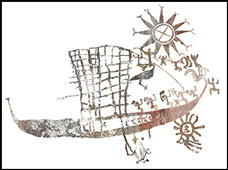Article contents
Dong Son drums from Timor-Leste: prehistoric bronze artefacts in Island Southeast Asia
Published online by Cambridge University Press: 18 February 2019
Abstract

Prehistoric copper and bronze objects are found throughout Island Southeast Asia, many of which were manufactured in Mainland Southeast Asia and exchanged over vast distances. The contexts of initial metal use and production across this maritime region are poorly known and rarely dated—particularly in the islands east of Wallace's Line. The authors report on two recent finds of bronze Dong Son drums in Timor-Leste, which, with their incised decoration, are examined in the context of elaborately shaped socketed axes depicted in the island's rock art, discussing their role and significance for understanding exchange networks and practices including raiding, headhunting and ceremonial activities.
Information
- Type
- Research
- Information
- Copyright
- Copyright © Antiquity Publications Ltd, 2019
References
- 5
- Cited by

